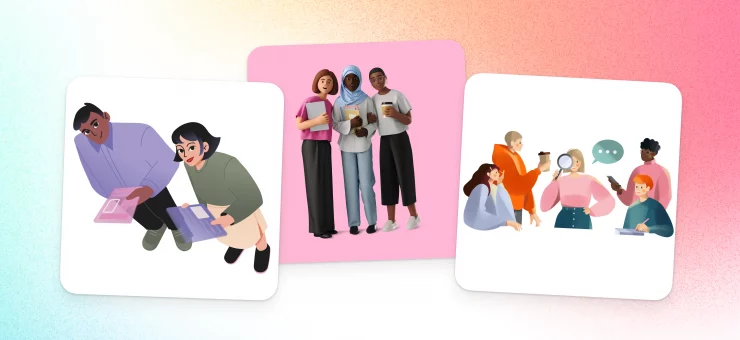Once in Phuket, a client staying in the presidential suite complained … that the sea is too noisy. How should people deal with such clients?
We bet that in your work, you also face complaints and accusations when nothing comes to mind except, “what should I do with it?”. Such clients or users are often called rowdies, but that is only one type of dissatisfied users or buyers. Dealing with them requires both effort and time. Yet, if you do match a key to them, you will save the company or product from the tons of negativity. In this article, we introduce the ten most common types of “toxic” users or clients and tips on dealing with them. Whether you work in management or support line, make sales in outsourcing companies or freelance for different clients, build interaction flows in user interfaces or answer the calls in the call center – this simple classification may help you to improve communication.
Rowdy
Once we have started talking about this type, let’s continue. Moreover, this type is one of the most difficult. Such clients are looking for not a product or service, but a reason to quarrel and shout (no matter if it’s in a store or in the review section of the ecommerce website). Even if you are perfect, and your competitors are daddling far behind, the rowdy will find something to complain about. The sea is too loud, the pizza is too hot, and a comma is missing in the medication instructions – aren’t these good reasons? The most annoying thing is that the negative feedback, especially emotional, always looks very convincing. Therefore, quite often rowdies’ reviews which fall into the public space spoil the company’s reputation.
How to deal with Rowdies:
- Keep an ear to the ground and regularly track the comments of this kind in the Web
- Don’t make excuses
- Agree with the client that his/her claim really deserves attention (even if it doesn’t)
- Try to meet the requirements, but if that’s impossible to do, prove the impossibility with arguments
- Offer an alternative (most likely, it will not work for this particular client, but the “public” will see your customer focus).
Hard-Liner
As a rule, that’s a middle-aged person who misses the good old days when “everything was better.” For example, the changes in the tariff plan. It’s difficult for a hard-liner to understand the benefits of your new offer if he or she has already got used to the old one, even if it’s not perfect. This type is very slow to move to any changes: it always seems to them that the old conditions were more profitable, and the old model was more reliable.
How to deal with Hard-Liners
- Be patient: it is difficult to convince people of conservative views
- Focus on the traditions and continuity of your product: show what is still the same as in the previous versions, explain the causes and benefits of the changes
- Offer to try without abandoning the old conditions
- Try to attract an opinion leader (beware: the critical thing here is to find someone whose opinion is really valuable and influential for your hard-liners; otherwise, you’ll get zero effect).
 Hard-liner photo collage on Moose
Hard-liner photo collage on Moose
Fearful
This type is also called “insecure.” The user of this type constantly doubts and is always in search of something else. Then they find – and start doubting again. The problem is that usually, this user doesn’t really imagine what he or she would like. Such a situation may arise from their general incompetence in your field: for example, he or she knows nothing about how the bicycles are designed while you are trying to explain something about the transmission. Another reason lies in the psychology of a person: the temperament, self-esteem, world outlook. Your trump card, in this case, is peace and confidence.
How to deal with Fearful:
- Find out how deep the client understands the topic and patiently explain what he/she does not know yet
- Identify the main barriers
- Offer a specific option and gradually incline an uncertain client to it
- Give clear arguments in favor of the chosen path, use facts, figures, statistics – it is important that a person sees the real advantages of your proposal.
 Fearful photo collage on Moose
Fearful photo collage on Moose
Smart Ass
This guy is sure that he knows everything about you and your business, and therefore, he is skeptical and arrogant in conversation. It is almost impossible to surprise, convince, or somehow emotionally influence this user – he knows everything. By the way, that often happens that the sources of his knowledge are unreliable, but you seem to be unable to do anything with that, he trusts them more than you. On the good side, the know-it-alls almost always have clear goals and requirements, as opposed to, say, Fearful users. Here you immediately understand if you can satisfy this user or not.
How to deal with Smart Ass:
- Let the client speak: listen to everything he tells you, speak on equal terms
- Pay attention to what he doesn’t know about your product yet
- Answer reasonably and factually – this type does not accept the other way of communication
- Listen to his remarks: he is most likely firmly established in the community with his know-it-all nature, he may be found communicating in forums, looking at reviews and can be a good source of user insights.
Freeloader
That’s the type of buyers/users that demonstrate their passion for bonuses. First, they seek out the most favorable (or rather the cheapest) conditions. Then they try to find options to reduce the price even more: promotional codes, special offers, using connection and pulling strings – depends on your business and communication channel.
If this is a freeloader of even higher level, then after the purchase he starts looking for something to complain about. But that’s not a simple play: he or she does it to get the compensation such as a return on value, an apology gift from the company, and so on.
An excellent example is described in the DoDo-book: a client declared that she broke a tooth with a pizza, and the company sent her a free pizza as an apology. After that, the woman began to call with this complaint every day – and every day she received a gift. Such a principle of communicating with clients is prescribed in the DoDo corporate policy, and in the end, the company still managed to get out of this situation with honor.
But what to do if you such a scenario is impossible in your case?
How to deal with Freeloaders:
- Adequately evaluate each claim you receive;
- Don’t keep at their back and call and do not rush to fulfill their demands, which sometimes border on insanity;
- Rely on the company policy and follow negativity instructions clearly: you don’t prevent a client from getting maximum benefits from the limits you set, but you also don’t have to go beyond.
- Of course, do not forget about being tactful and polite – you will need that when the client realizes that you do not make concessions and gets angry.
Timid Mouse
This type is similar to Fearful users, but with its own nuances. While the Fearful does not know what he or she wants, the Timid Mouse knows but does not tell. All the information must be literally pulled out from this person. Such clients may seem completely satisfied and loyal, and then suddenly you discover that they have moved on to competitors. Why? Because it turns out that you didn’t satisfy them in some aspects, but they didn’t find it necessary to tell you about it – they just found another contractor or supplier.
How to deal with Timid Mice:
- Thoroughly clarify the client’s needs and only then begin to act (this will raise the relevance of the offer and minimize the likelihood of dissatisfaction)
- In no case lose touch, regularly initiate communication
- Explain the principles of your work and the reliability of the company: sometimes customers are reluctant to share information because they aren’t sure that the company is trustworthy.

Chatterbox
“I’m not shopping, I just want to talk” that’s about them. Such users are a bad dream for all call operators and support workers. That’s because corporate communication and personal time are spent in huge amounts, the clients who really need support are waiting for their turn, but there’s little use in talking to Chatterboxes. You will learn everything about their interests, their needs, their personal experience, the experience of their mother’s friend’s son — just because, with no use or specific goals.
How to deal with Chatterboxes:
- Never stop the conversation abruptly or put down the client – Chatterboxes are emotional and vulnerable, so if you offend them, with the same great flow of talks they will carry a rumor about how bad you are to the masses
- Adhere to the business tone of communication, do not allow the conversation with the user to move into the category of “personal” (they are doing their best to achieve that);
- Use closed questions (be sure they will not be limited to one “yes/no”, but at least you will try)
- Take the initiative and keep it as long as possible.
 Chatterbox photo collage on Moose
Chatterbox photo collage on Moose
Lazybones
Strangely enough, but “always hurrying” clients also fall into this category. They are not interested in any product, or benefit, or brand. The only thing they are looking for is the speed and convenience of the transaction. If they can buy from your competitors in one click and you don’t give that option – the audience of Lazybones is already lost for you. If you have entered a mandatory registration or any other additional steps, you can immediately remove this category from loyal customers and expect their discontent in the reviews. Or do not expect, because to write a review, you also need time and effort, which is always lacking as of lazy people.
How to deal with Lazybones
- Examine your target audience and decide whether it is worth changing to satisfy this type of clients
- If necessary, adapt the interaction process so that it would be as effortless as possible for the client
- Try to establish a personal connection with the Lazybones – if the competitors are faster, but you are more pleasant, they may still think
- Influence through emotions: fears and pains that can be handled only by you.
 Lazybones photo collage on Moose
Lazybones photo collage on Moose
Preconceived
The user of this kind is biased either after a failed interaction with the company or a competitor company or even after having heard a lot about the failed experience from other users. It is easy to assume that such clients rarely return to the company, but there are situations when there is no choice to go somewhere else. Therefore, biased people return, but firmly prejudiced that nothing has changed and this time their experience will be even worse.
How to deal with Preconceived
- Find out the source of prejudice and, if the situation allows to do it, solve the previous issue
- Demonstrate what you have done to prevent such troubles
- Try to establish trusting personal relationships to influence the client’s position.

Alarmist
Anxiety is their middle name and the usual state of life. If something gets outside their control, that is a reason for panic.
Such clients are accustomed to working according to their own scenario, and if this is not provided in your company or with your product, they are offended and move to competitors.
How to deal with Alarmists:
- Answer every question clearly and patiently – that is the only way you can gain trust
- Give examples from the real experience of solving non-standard force majeure situations in order to prove your competence and reliability
- Try to satisfy the requirements or prove their incorrectness
- Offer guarantees that would satisfy the Alarmists.
 Alarmist photo collage on Moose
Alarmist photo collage on Moose
To Sum Up
Toxic customers are found in any business, so it’s impossible to get insured fully. But clearly defining their type and knowing how to find an approach to each of them is what you can really do. We hope that our classification and the memo will help you a little on this never-easy path.
This post is the translation of the article published on Likeny Blog.
All photo content from Moose Photo Stock
Check the strategies helping designers to stand out, learn more about the types of clients that end up in designer’s hell, and explore the practices of visual storytelling






